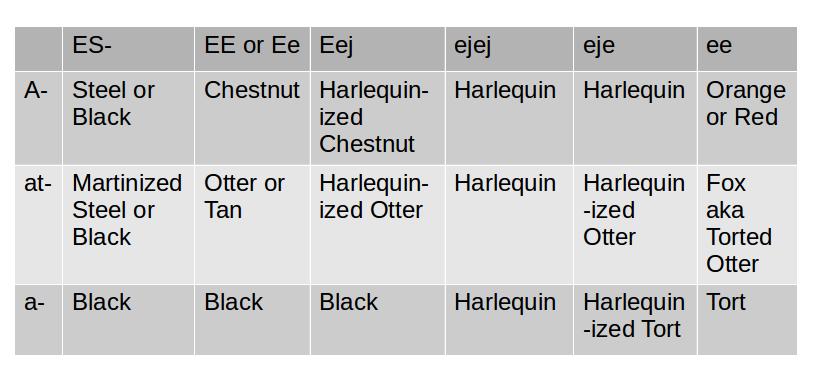The “A” Locus and the “E” Locus in Rabbits and how they Work Together
A couple of definitions and a brief discussion:
Allele: An allele is a different version of a gene. These are caused by mutations and sometimes (not always) change the function of the gene. In this context, the mutations we will be discussing, affect how the genes produce pigment (ie rabbit color). The original color (ie allele) is called the “wild-type” allele.
Locus: This is the gene where the alleles occur.
Dominant: Takes precedent over another allele. “Strongest”
Recessive: “Weakest”
All rabbits have two alleles (and only two alleles) at each locus (ie each rabbit has two copies of each gene). The dominant allele will mask the expression of the recessive allele. This means that if a rabbit is AA, Aat, or Aa at the “A Locus” only “A” will express because it is the most dominant of the alleles. Because “a” is the most recessive of the alleles, a rabbit will only express “a” if it is “aa” at the A locus. If it had any of the other alleles those alleles would “overwrite” the “a” causing it to be “hidden”. The rabbit would still carry the “a” allele and possibly pass it to offspring but it would not express in the original rabbit. Even though there are 3 alleles possible at the “A locus” a rabbit can only have two of these three possibilities.
ASIP (A Locus): Possible Alleles in order of Dominance A, at, a. “A” is the wild-type allele. All other alleles at this locus are mutations. Rabbits that have the “A” allele at the A locus are commonly called “Agouti".
MCR1 (E Locus aka Extension): Possible Alleles in order of Dominance ES, E, eJ, e. “E” is the wild-type allele. All other alleles at this locus are mutations. Rabbits that are “e” at the E Locus are commonly called “non-extension”. As with the “A locus” a rabbit can only have two of the possible 5 alleles at the “E locus”.
These two genes, ASIP and MCR1, are the base of all rabbit colors. Once you understand how these two genes combine to create different “base colors” you can then begin to add other dilutions, modifiers, and even white patterns (ie Broken and Vienna) without much difficulty.
All rabbits have a “base color”. Dilutions and Modifiers can change the appearance of the rabbit but the “base color” will stay the same. Think of it as frosting on a cake. You can dress up the cake and add many “layers” of frosting, however, it doesn't change the type of cake. A chocolate cake is still chocolate no matter how many different “layers” of frosting are added.
Once again, because some alleles are dominant they “hide” the other allele that is present. Because of this it is impossible to know what that other allele may be without breeding tests or known parentage, these “hidden” alleles will be represented with “-”.
Consider the below chart. It contains all the basic combinations of colors in rabbits, even some of the more unusual ones. Now all you have to do is add "layers". For example add chocolate to any of these and you get a slightly different color but the "base" color is still the same. If a rabbit is EE AA (chestnut) with chocolate (bb) it is a chocolate agouti. The color names do vary from breed to breed but the basic understanding of the genetics stays the same. 